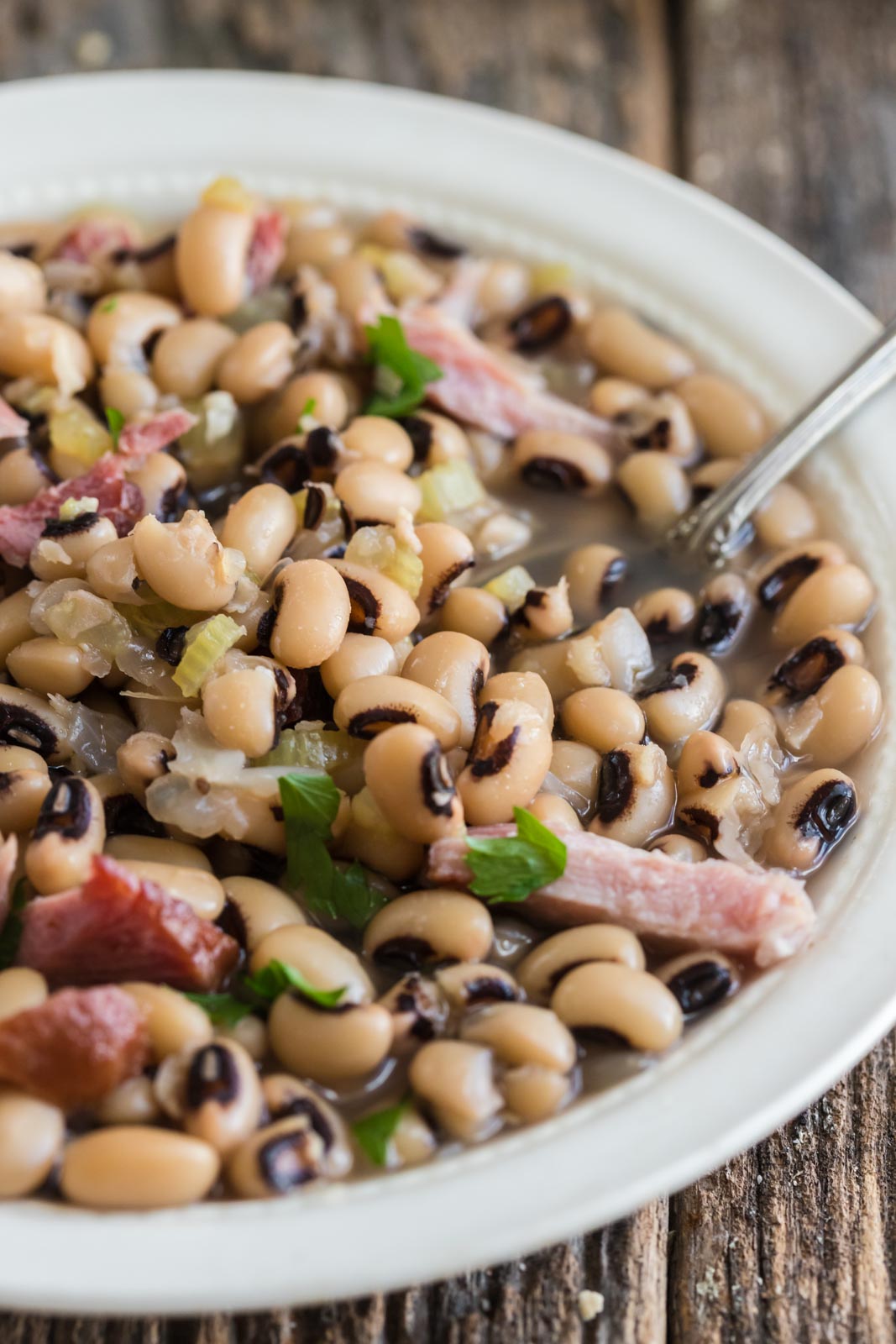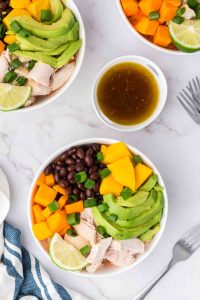New Year’s Black Eyed Peas with Ham
New Year’s black eyed peas with ham are supposed to bring good luck and fresh starts but I really think we eat them because just because they taste so good. Get the classic southern recipe and easy method to make these for your next winter meal.
Jump to Recipe
What is a black eyed pea (Not the band!)
Black-eyed peas are small white beans marked in the most common varieties, by a black spot.
The spot can also be brown, green, pink, or red and marks the place where the bean attaches to the pod it grew in. They are generally medium in size, but also come in heirloom varieties that boast a greater mass.
The black-eyed pea is a subspecies of the cowpea and is sometimes called by the same name.
Are black eyed peas healthy?
Black-eyed peas have a number of benefits that can help one achieve health goals.
- They are an excellent source of fiber, allowing slow breakdown and sustained energy.
- They contain a number of vitamins and minerals such as calcium, vitamin A, iron, magnesium, manganese, folate, copper, and zinc and, as such, can contribute to healthy weight loss, vision, fetal development, and better digestion.
- The nutrients in black eyed peas may also support healthier blood and defend against diabetes.
Why do people eat black eyed peas for New Year’s Day?
Black eyed-peas are often enjoyed on New Year’s Day in a superstitious stab at manifesting good luck for the coming year.

It is said that the idea came from the time of the Civil War when soldiers would leave black-eyed peas behind in southern states. Those who were lucky enough to come across them enjoyed them in celebration of needed nutrients.
To this day, many enjoy this legume with the mindset that they encourage luck and prosperity.
Why soak black eyed peas before cooking
As with any legume, it is crucial to soak black-eyed peas before cooking and eating them.
This process not only allows the legumes to cook faster, but it also breaks them down a bit so that they are more easily digested and so that their nutrients are more easily absorbed.
When soaking black-eyed peas, use a 3 to 1 ratio of water to beans, adding 2 tablespoons of kosher salt for every pound of beans.
Make sure to drain then rinse the salty water from the beans before adding fresh cooking water or broth.
Liquids to cook in
Feel free to cook your black-eyed peas in water, but don’t shy away from adding some flavor.
A good quality stock or broth does wonders when it’s time to cook them (I love making my own).

What kind of ham to add to black eyed peas
If you are adding ham to your black-eyes peas, which I highly suggest, go for the real deal as opposed to ham bullion or add ins.
I am a BIG fan of using a ham hock, which can often be found in your local grocery store if you are in the southern region of the U.S, or you can order hocks online.
If you are having trouble finding a ham hock, go ahead and use a few slices of good, thick cut bacon.
Add in ideas to boost flavor
Aside from that smokey ham flavor achieved from the addition of a ham hock and/or bacon, feel free to get creative!
Some flavors to try:
What happens if you don’t soak black eyed peas?
Everyone knows that old saying “Beans! Beans! Good for the heart. The more you eat eat ‘em the more you…”. Well…you know what I mean.
Soaking your black-eyed peas will significantly decrease any gassiness you might experience from eating legumes.
An added benefit of soaking is that your cook time will be significantly less–like a couple of hours less. So it’s worth it to pre soak.
Can black eyed peas be made in advance?
Black-eyed peas are a great candidate for make ahead meals/sides. Go ahead and make them up to a week in advance and once they have cooled, store them in an airtight container in the refrigerator.
Upon reheating, they will soften and run the risk of breaking apart some, so make sure to stir them gently so that they maintain their shape.
What to serve with black eyed peas
Black-eyed peas are delicious on their own, but are even tastier when served alongside some cornbread, cooked greens, or sliced onions.
Some even cook their greens in with the black eyed peas. Yum! Here are a few of my favorite recipes.
How long do black eyed peas last in the refrigerator?
As noted above, you can absolutely make black-eyed peas in advance. They should keep in the refrigerator for about a week. As always, make sure to store them in an airtight container.
Can black eyed peas be frozen after they’re cooked?
I do not recommend freezing black-eyed peas. They will not maintain a pleasant texture through thawing and reheating.
Our Favorite
Sides to serve with black eyed peas

New Year’s Black Eyed Peas with Ham
Ingredients
- 2 cups dried black eyed peas washed, and checked for stones or dirt
- water to cover
- 6 cups chicken broth low sodium if using pre made
- 1 ham hock
- 2 cloves garlic
- 2 stalks celery chopped
- salt and pepper to taste
Instructions
- Add the dried peas to a large bowl and cover with cold water by two inches. Add 1/2 tablespoon kosher salt and soak overnight. Drain then rinse the peas before proceeding.
- If you can't soak overnight, add the peas to a pot, cover with water (no salt) and bring to a boil then turn off and let the peas sit for one hour before continuing. Drain this liquid before proceeding.
- Fill a large pot with chicken stock or water, add just the ham hock and simmer for 30 minutes to soften it, then add the peas, celery, diced onion and garlic.
- Reduce heat to medium low, cover and simmer gently until the peas are soft; about 2 1/2 to 3 hours.
- Remove the hock, peel away the tough outer skin and shred the ham that's left. Add the ham back to the pot.
- If you're using chopped collard greens, stem and dice them roughly then add them to the warm peas to simmer for 5 to 10 minutes until soft. Serve warm. Refrigerate any cooled leftovers for up to five days.







About the Author
Rachel Ballard, RN, BSN brings more than 20 years of professional nursing expertise to Feast and Farm. With a love for nutrient dense foods that support wellness, she works to distill complex health information and current trends into recipes that fuel the best version of yourself. Read more about Rachel here.